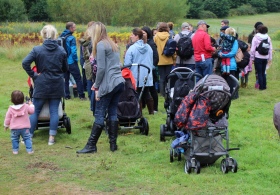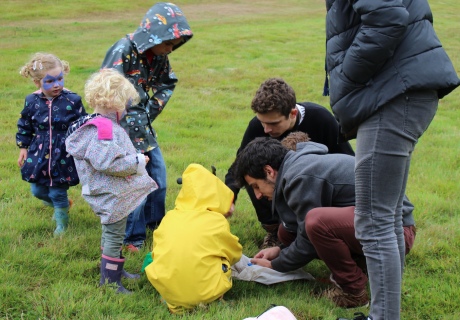Biggest ever 'Bugs! Day' held at Silwood Park campus
More than 500 people tried their hand at everything from pond dipping to insect hunts at the third annual Bugs! Day.
The public event was organised by Imperial’s Grand Challenges in Ecosystems and the Environment group (GCEE), and attracted its biggest ever attendance with visitors enjoying a host of exhibits, demonstrations, bug-hunts and talks on all things creepy-crawly.
It is a really enjoyable and useful experience for the research groups
– Sam North
PhD student and organiser of Bugs! Day
Imperial scientists working on a diverse range of topics related to insects and other invertebrates brought along interactive activities that gave people of all ages and backgrounds the chance to get hands-on and discover the ground-breaking research being carried out in the Department of Life Sciences. Exhibits included a live bumblebee nest, make-your-own insect craft activities and hunting for live insects in the beautiful grassland and woodlands of Silwood Park.
Creepy-crawlies: Contagious fun at Bug! Day

Taking place on the first day of the school summer holidays for many children, the event was an exciting and educational way to kick off the long break; the enthusiasm from the many families who participated was contagious. Squeals of excitement could be heard as young bug-hunters found their first grasshopper, and a few ‘yucks’ from pond-dippers who discovered a slimy leech in their net.
Mother-of-two Debbie said: “This is the second time we have come along to Bugs! Day with our family and we’re really enjoying it so far. Our children are seven and nine and were so excited to be coming back to see what they could find this year – during the bug hunt we found out about the differences between a grasshopper and a cricket, and saw lots of caterpillars. We’ve also made our own bug hotel and seen a queen bumblebee in her nest. It’s a lot of fun and free too!”

Imperial's Silwood Park site has 100 hectares of undisturbed grassland and woodland habitats and hosts many ecological experiments, as well as providing essential homes for wildlife. Several popular bug hunts were run during Bugs! Day, led by local wildlife expert Trevor Smith and Imperial Masters student Koorosh McCormack.
Visitors were able to try their hand at ecological surveying techniques such as sweep-netting, as well as being shown the best places to hunt for insects. Some of the species found during the day were: Nowickia ferox, Eupelmus vesicularis and a labyrinth spider (Agalena labyrinthica) – these represent just a fraction of the diversity of invertebrates found at the greenest of Imperial College’s campuses.
Engaging the public with wildlife
The group of researchers behind Bugs! Day work on the three themes of the GCEE initiative:
- sustainable food, water and health
- managing target species in complex ecosystems
- predicting and mitigating environmental change
Outreach projects like Bugs! Day play an important role in the wider impacts of the GCEE’s integrated research programmes.
PhD student Sam North has been in charge of the organising team for the past couple of years and was enthusiastic about how the event has gone from strength to strength.
“We’ve increased the number of activities on offer to visitors at this year’s Bugs! Day and have also brought in more partner organisations such as the Royal Society of Biology and Butterfly Conservation, and this has helped broaden out the topics people who visit can learn about,” he said.
“It is a really enjoyable and useful experience for the research groups who run activities and a rare opportunity for people who live near Silwood Park to chat to experts about the wildlife in their area.”
Bugs! Day features in Imperial's August Podcast
Listen to the highlights from Bugs! Day including interviews with researchers and visitors as it features in the August 2017 Imperial Podcast.
Article text (excluding photos or graphics) © Imperial College London.
Photos and graphics subject to third party copyright used with permission or © Imperial College London.
Reporter
Penny Fletcher
Office of the Provost